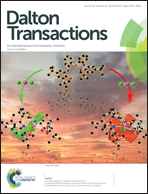Novel CuII–MII–CuII (M = Cu or Ni) trinuclear and [Na I2Cu II6] hexanuclear complexes assembled by bi-compartmental ligands: syntheses, structures, magnetic and catalytic studies†
Abstract
In the present work, two compartmental ligands H2L1 and H2L2 were in situ generated during the syntheses of new trinuclear complexes, [Cu2Ni(L1)(2,2′-bpy)2(NO3)2][ClO4]2 (5), [Cu3(L2)(NO3)2][ClO4]2 (6), and [Cu3(L2)(NCS)2(NO3)]+ that co-crystallize in 7 with a [Cu6(L2)2Na2(NO3)6(NCS)4] unit to give the final molecular formula [Cu6(L2)2Na2(NO3)6(NCS)4][Cu3(L2)(NCS)2(NO3)]2(NO3)2·5H2O (7). The magnetic property studies of 5–7 revealed weak CuII–CuII ferromagnetic interactions in compound 6 (JCu–Cu/kB = +1.4(1) K) and 7 (JCu–Cu/kB = +1.6) while in intranuclear CuII–NiII–CuII compound 5, the magnetic coupling between two CuII ions is switched off by the diamagnetic square planar NiII bridge. The catalytic epoxidation of two olefins, namely styrene and cyclooctene, by tert-BuOOH (TBHP) was also explored in the presence of a catalytic amount of 5, 6 or 7 in MeCN. For styrene oxidation, 5 exhibited ∼57% styrene epoxide selectively (conversion ∼37%) with a TON of about 925 along with benzaldehyde (∼43%), whereas 6 exhibited conversion up to ∼63% (TON ∼ 1575) with a good selectivity towards epoxide (∼71%). For compound 7, this conversion is more important (TON ∼ 8108) probably due to the presence of more active sites involved in the epoxidation. The concerted path was found to be operative for styrene oxidation while a radical path was suggested for the oxidation of cyclooctene.
![Graphical abstract: Novel CuII–MII–CuII (M = Cu or Ni) trinuclear and [NaI2CuII6] hexanuclear complexes assembled by bi-compartmental ligands: syntheses, structures, magnetic and catalytic studies](/en/Image/Get?imageInfo.ImageType=GA&imageInfo.ImageIdentifier.ManuscriptID=C4DT03728F&imageInfo.ImageIdentifier.Year=2015)

 Please wait while we load your content...
Please wait while we load your content...